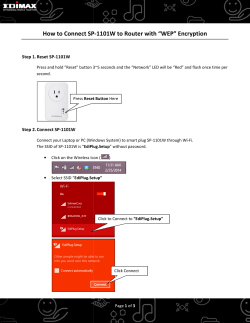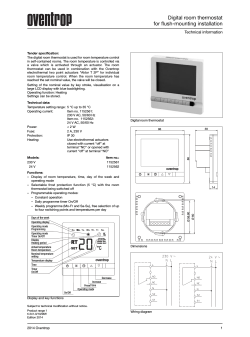
User`s manual for monitoring, automation and remote control Module
User’s manual for monitoring, automation and remote control Module “Mini-Monster16” v. 1.2 English § 1. About the Module – general information The Module is based on microcontroller (by Atmel). The Module can be connected to standard IEEE 802.3 Ethernet network. The Module has miniweb-server, with web-interface, working over standard TCP/IP v.4 protocol. There are six outputs on the Module for user to connect relays (5, 12, 24 v) for electric load control. There must be the same power supply to the Module and relays to work properly. There is a possibility to connect digital thermal sensor (the Module is originally designed to DS18B20). The Module has also automatic functions: thermostat on output 1 and ethernet watchdog on output 2. Then, functions of the Module are: – electric load control; – temperature monitoring (originally designed for Celsius grade); – automated electric load control according to temperature (thermostat function); – host (in TCP/IP network) accessibility monitoring; – automated electric load control according to host accessibility (ethernet watchdog function); § 2. Technical specifications of the Module Size (W*H*D) .................................... 27*30*31 mm Vin power ........................................... 5-24 V DC Consumption current .............................. 210 mA (5V) Ethernet ............................................. 10Based-t Relay driver ......................................... ULN 2003 Outputs amount .............................................. 6 Max relay control power consumption ................. 300 mA Relay voltage ............................................. = Vin Thermal sensors can be connected ........................... 1 Thermal sensors type ................................... digital 1 Thermal measurement range ..................... -55...+99 CO Thermal measurement accuracy ....................... 0,1 CO Operating temperature of the Module ............ +10...+40 CO Operating humidity level ........................... 20%...80% 1 Originally designed for DS18D20 § 3. Schemes and connections General view of the Module, from the front of Ethernet socket General view of the Module, from the “back” (side with outputs) Inputs and outputs (top view of the Module) Connection schema Service pads and pins (“bottom” view of the Module) § 4. Web-interface and controls The Module has web-interface, and can be accessed via TCP/IP after connecting to Ethernet and power supply. Defaults are: – – – IP: 192.168.0.12 Password: password MAC: F0-F1-09-E4-01-FF So after first switching-on the Module can be accessed at address http://192.168.0.12/password Web-interface general look: Control sections: MAIN - displays states of outputs and allows to switch outputs. Color of output number shows the state at the moment (green - on, red - off.). Item «save as default» allows to save current states of outputs (on or off) as the default state (after reset, for example, outputs will automatically be returned to a given state). String “t = “ displays the current temperature in Celsius form the temperature sensor connected. If the sensor is not connected, «no sensor» will be displayed. Temperature measurement is independent from the thermostat function. THERMO - setting the thermostat function. The switch allows you to enable or disable the thermostat (automatic output 1 control). Temperature measurement is independent from the thermostat function. If the thermostat is turned on, the first switch in the MAIN section will be replaced with the inscription «thermo», and manual control of this relay will be switched off. String “t = “ displays the current temperature. “Output” shows the current state of the output. “Refresh” allows you to do manually refresh of the state. “Target” parameter is used to set the target temperature. The temperature can be set in both the positive (by default, that is, without the sign of the value or the “+” sign before the value) and negative (“ - “ sign before the value) ranges. Saving a given parameter is done by pressing the button Save. “Hysteresis” parameter allows to specify a range of operating the output. The value is absolute and unsigned, tenth of a degree. This value will be added to the «Target» when high-threshold will be reached, and will taken away when the temperature lower threshold will be reached. For example, when temperature of 20 degrees is set, and a hysteresis is set 1 degree, thermostat will switch output on on 19 degrees and will switch output off on 21 degrees. Saving will be done by pressing the button “Save”. The last parameter allows you to adjust the sensor, as different sensors often has errors (usually linear) within two degrees. This value can be positive or negative. This parameter is always added to or subtracted from the data obtained from the sensor, and the page displays the corrected value. Thermostat also works with corrected by this parameter temperature value. Saving a given parameter will be done by pressing the button Save. W-DOG – allows automatic hardware reset for host in case it is not available in the Ethernet, whose AC or DC power supply can be controlled via Module's output and relay connected to that output, Here can be set the address of the target machine and additional network settings. Checking availability goes via TCP/IP through the ICMP (PING). The frequency of checking and additional parameters automation can be set here. The function is enabled, if the parameter “interval” is non-zero. In this case, the output 2 in the main section will be replaced with the inscription “W-dog”, and a string of reset statistics (“W-dog stat = x”). Manual control switch will be turned off and will be replaced by reset switch. In this case manual reset will be performed accordingly to settings. The string “host” specifies the ip-address of the host that will be monitored. The address format is xxx.xxx.xxx.xxx, for example 192.168.10.5. If the host was not found, «not found» will be displayed. The string “gateway” specifies the gateway in the local network to allow monitoring of hosts that locates in different subnets. The address format is xxx.xxx.xxx.xxx, for example 192.168.10.1. These two parameters will be saved by pressing “Save” button, located below the “gateway”. If the function is enabled, after the reset section resets statistic will be showed. The “interval” parameter specifies the time interval in seconds after which the availability check will be performed. The range of values is from 1 sec. to 255 sec. 0 means deactivating the function. “Reset interval” parameter specifies the time (in seconds) between switching output off and on (power-on reset). Can be set from 1 second to 255 sec., recommended for at least 2 seconds. “Lost before reset” parameter determines the number of packets lost (no response for a request to the host)before the reset will be performed. For example, if “Ping interval” = 2 , and “lost before reset“ = 4, then reset will be done in 2 * 4 = 8 seconds if no response from the host was got in this eight seconds. If at least one response is received, the no-response-counter will be set to zero . “Wait after reset” parameter determines the check delay after reset. For example, if the computer is rebooted, it will be available in the network after approximately 2-3 minutes. At this time, computer will be inaccessible from network, and checking is useless. The parameter can have a value from 1 to 65535 seconds. “Failed resets” parameter determines how many times the equipment can be resetted if the answers are not received after the restart. After the specified number of restarts, if there will be still no response from the host, Watchdog function will be disabled. The value can be from 1 to 255. SETTINGS - common Module settings «IP» specifies the IP address of the Module in a local network. Default Address - 192.168.0.12. “MAC” specifies the physical MAC address of a unique Module. Not all values of hex are correct MAC addressess, so do not change unless necessary. Default - F0-F1-09-E4-01-FF. “ID” specifies the name (just a label) of the Module. Default “MiniMonster”. “Pass” is the password to the Module. Default - “password”. § 5. Miscellaneous Settings of the Module are stored in non-volatile (EEPROM) memory, so after the power settings they will be preserved. All the data is stored in EEPROM of the Module excepts Watchdog function statistics. To reset the Module to the factory defaults, connect the pads when turning the Module on (see Section 3). There is possibility to reprogram the Module by user who can do it by self. Programming can be accomplished by using programming pads and socalled “pogo-pins” or by soldering the wires to pads. Pads location is specified in paragraph 3. For a more accurate measurement of the temperature sensor is recommended to connect to the pigtail with the length of the unit at least 10 cm. Do not recommended to use the Module at temperatures below +10 ° C and above +40 ° C. The Module was not long tested at this temperatures. If exploitation for the temperature measurement in not-recommended temps is needed, may use an extension cord to connect the temperature sensor.
© Copyright 2025











